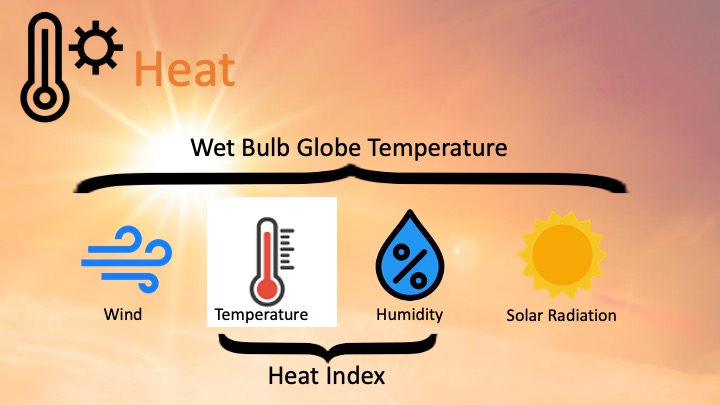3019 Shannon Lakes North, #203 Tallahassee, FL 32309
Find your Weatherstem unit:
Innovation in Heat Monitoring and Alerting
Most officials concerned with public safety have been relying on a metric called Heat Index to assess the severity of a hot weather outbreak and how it may negatively impact people and animals.
Heat Index is a mathematical derivation of temperature coupled with humidity, but, it turns out there's a much more complete metric that incorporates radiation and wind as well.
It is called Wet Bulb Globe Temperature (WBGT) and all Weatherstem sites report real-time as well as forecasted values of WBGT.

Some states, such as Georgia, REQUIRE WBGT to be measured and recorded before any public activity commences.
We have created an educational resource about WBGT that we recommend you check out at this link.
How Weatherstem Measures WBGT
A standard formula for computing WBGT is:
WBGT = 0.7Twb + 0.2Tg + 0.1Ta
Where Twb is Natural Wet Bulb Temperature, Tg is Globe Temperature, and Ta is Dry Bulb/Ambient Temperature.
Twb is easily computed from the Weatherstem station's Thermometer and Hygrometer sensors. Ta is simply the Thermometer reading. Tg is computed based on inputs from the Radiometer sensor and the Thermometer sensor based on the work of Okada and Kusaka:
https://www.jstage.jst.go.jp/article/agrmet/69/1/69_69.1.4/_pdf
Weatherstem's computation of WBGT is an implicit measurement we compute from the values of several explicit measurements made by a Weatherstem station, namely:
- Temperature (
T) measured by a Thermometer - Wind Speed (
U) measured by an Anemometer - Solar Radiation(
S) measured by a Radiometer - Pressure (
p) measured by a Barometer - Dewpoint Temperature (
Td) measured with the aid of a Hygrometer
Standard Weatherstem instrumentation has these core sensors that are indispensable in the derivation of WBGT.
If you think about the parameters upon which WBGT is based upon, some of them are very hyperlocal in nature. For instance, wind speed can vary dramatically from one point to another point nearby yielding very different WBGT values.


Weatherstem is able to make multiple WBGT measurements at different locations at a single venue with the placement of multiple, satellite sensors that can give a more complete understanding of the WBGT conditions at the venue.

In a stadium environment, for instance, WBGT measurements can vary greatly from one part of the stadium to the next as illustrated in the example here at Texas A&M University Kyle Field.

Using Weatherstem's Event Architecture, you can configure any WBGT sensor (as well as ANY sensor) to trigger notifications delivered by text, e-mail, etc. based on observed and/or forecast WBGT readings.

Weatherstem WBGT JavaScript Library
Are you curious about our mathematical derivation of WBGT?
You can access our WBGT JavaScript Library at:
https://www.weatherstem.com/wbgt.js
Feel free to use it in your projects and we welcome feedback you can send to api@weatherstem.com.
Weatherstem Heat Forecast API
We have a JSON-based API that outputs current and 15-day WBGT and UV index forecasts for most all spots in the World.
Simply make a call to
https://heat.weatherstem.com/LATITUDE,LONGITUDE
For instance:
https://heat.weatherstem.com/30.5359095,-84.2135715
Feel free to use it in any of your projects!